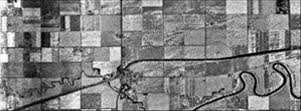
Natural Resources Canada > Earth Sciences Sector > Priorities > Canada Centre for Remote Sensing
Slant Range and Ground Range
5.7 Slant Range and Ground Range

Slant Range and Ground Range |
Hn = flying height ß = depression angle

Slant Range Image |

Ground Range Image |
Radar imaging systems record the differences in travelling times between return signals. The distance between an
object and the antenna is equal to the speed of propagation of the wavelength through the atmosphere multiplied by the time it takes to reach the antenna. This, of course, is the relationship between the speed of EM radiation, time taken and distance travelled. A direct relationship between the slant range and the ground range also exists. Since we know the angles at which the microwaves are propagated, we can use trigonometry to calculate the ground range.

Slant range |

Ground range |
In order to view a radar image in the more recognizable ground range configuration, a geometric correction between the two distances is made.

Geometric correction |
Ro, ..., Rk, ..., Rn = slant range (km)
Hn = satellite altitude (km)
 = illumination angle = illumination angle
 = Earth centre angle = Earth centre angle

The slant range to ground range distortion is much more pronounced in airborne SAR systems than it is in satellite SAR systems. This is a result of the difference in depression angles and the range of the depression angles between airborne and spaceborne SARs. The slant range to ground range correction may not be necessary in order to create an effective stereo pair from satellite SAR imagery.
| 